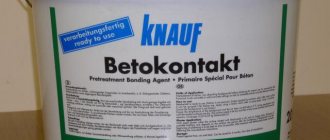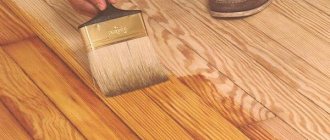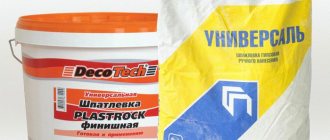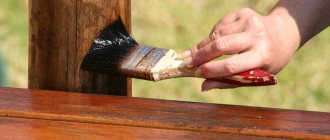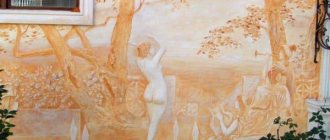At the turn of the 20th and 21st centuries, a large number of diverse materials entered our everyday life. And it is sometimes difficult for an inexperienced person to figure out in which cases one should be used and in which another. Moreover, many of them appear mainly in the form of abbreviations, which makes it even more difficult to understand their purpose. Let's figure out how MDF differs from PVC - these are, perhaps, one of the most common materials in construction and some other types of human activity.
Deciphering abbreviations
MDF
PVC
MDF is an English abbreviation, that is, in the original it will be MDF. Having deciphered it, we get MediumDensityFibreboard, which translated into Russian means “medium density fiberboard”. It is made by pressing wood chips in a dry environment at high pressure and temperature. Urea resins are used as a binding material, which reduces the emission of harmful formaldehyde to natural. The USA was the first to establish industrial production of MDF boards (this happened in 1966), and Russia joined their production only 31 years later. Well, the leader in production today is (as expected) China.
The difference between MDF and PVC is that the second material is a product not of the woodworking industry, but of the chemical industry. PVC stands for polyvinyl chloride. This clear plastic is a thermoplastic polymer of vinyl chloride (a colorless gas with a sweet odor). PVC is highly resistant to many aggressive substances - acids, alkalis, mineral oils. It does not burn in air, but has poor resistance to frost, poorly tolerating temperatures below -15 degrees Celsius.
Definition
MDF - a material made from dried wood fibers treated with synthetic substances, is defined as an MDF profile.
The concept of MDF took its roots from the English language. And in simple words, this is a tile material formed by dry pressing of small wood chips at fairly high pressure and temperature.
MDF
PVC ( polyvinyl chloride ) - this type of material belongs to the group of thermoplastics. Thermoplastic, in turn, is the same plastic that remains recyclable even after the product is molded.
PVC
The main differences between PVC and MDF
Despite many identical properties, there is still a difference between PVC and MDF panels, and a very significant one. The differences lie in the physical and technical properties of the materials forming the panels and their structural structure. The materials forming the panels differ significantly in relation to fire safety. While PVC and MDF do not burn on their own, they both support combustion. High-temperature decomposition of PVC leads to the formation of more toxic combustion products and significant smoke. MDF does not emit critically toxic substances in the event of a fire, but the temperature of maintained combustion is much higher.
Another significant difference associated with the physical properties of the forming materials is the attitude to the increased moisture content in the environment surrounding the panel. Panels made from polyvinyl chloride polymer are absolutely insensitive even to direct exposure to water. The wood-fiber structure of MDF panels is hygroscopic and, with prolonged exposure to humid air, swells until it completely collapses.
These properties predetermine the advantage of PVC for use in rooms with the possibility of exposure to high humidity: bathrooms, garages, loggias. The pressed wood fiber material is strong throughout its entire mass. The PVC panel has a hollow internal structure. The thickness of the outer walls of PVC panels does not exceed 1.5 mm, so they cannot withstand even minor impact loads. In terms of their ability to withstand mechanical stress, MDF panels are superior to polyvinyl chloride parts.
Formaldehyde
Formaldehyde is a toxic gaseous substance that has a sharply negative effect on the human body and health. Formaldehyde enters the body through inhalation.
| Little is known about this to the general public, but contact with this substance occurs every day, since it is formed not only industrially and is found both in furniture and cosmetics (bath bubbles, shampoos, disinfectants, etc.), but also naturally (in the environment and even in the human body). |
Despite the harmfulness of formaldehyde, its content in small (permissible) quantities has practically no effect on the human condition.
Here is the conclusion from the essay of a 4th year student at Ivanovo State University Litvinenko I.S. on the topic “THE INFLUENCE OF FORMALDEHYDE ON THE HUMAN BODY AS A RESULT OF WOOD PROCESSING ACTIVITIES,” written under the guidance of E.P. Turkina, Candidate of Biological Sciences: “Phenol formaldehyde is a very toxic substance. It is quite difficult to reduce its effect. Once the gas enters the body, it changes greatly. Upon decomposition, it is transformed into formic acid, or methyl alcohol. Of course, the best defense against this carcinogen is to avoid places and areas where it can be found in high concentrations. These are, first of all, traffic jams, industrial areas, furniture factories. It is also recommended not to linger in rooms that are not ventilated. One of the best helpers in reducing the impact of formaldehyde in office spaces and at home can be indoor plants. A number of them have the excellent property of absorbing formaldehyde from the air.
Advantages and disadvantages
Like any building material, MDF and PVC panels have a number of positive qualities, and maybe even a few disadvantages.
MDF
One of the first and main advantages of MDF panels is significant cost-effectiveness . Indeed, compared to wooden materials, the cost of MDF is impressively lower. This material also has the following advantages:
- High resistance to temperature changes and high air humidity.
- No sagging due to its hollowness.
- Resistance to various mechanical deformations and fungal infections.
But there are also disadvantages to panels of this type. The MDF panel cannot in any way be classified as a durable material . Plus, during use, the top part of their coating can wear off.
PVC
Speaking about this material, we can immediately take the example of popular plastic windows. There are also a considerable number of advantageous properties in the use of polyvinyl chloride, namely:
- High durability.
- Resistant to various types of atmospheric environments.
- Aesthetics in appearance.
- Tightness, which means a high level of thermal insulation and sound insulation.
- Ease of use. This profile is not capricious in terms of caring for it.
- Environmentally friendly and absolutely harmless to humans.
The most important quality that polyvinyl chloride has is that it is an inexpensive natural thermal insulation material.
Speaking of the minus, we can say that plastic panels (PVC) are highly flammable , plus plastic panels in a minimal ratio are able to withstand environmental influences. For example, when the surface is exposed to sunlight, the plastic may begin to melt, emitting a rather unpleasant odor.
How do laminated PVC panels differ from other types of panels?
Laminated PVC panels are made entirely of polyvinyl chloride. Polyvinyl chloride - PVC for short - is a synthetic polymer that is made from natural materials: table salt and petroleum products. PVC is the most common type of plastic, which is characterized by a given strength, as well as being versatile and economical to use. The main consumer properties of PVC are:
- Strength;
- Durability;
- Resistant to water;
- Resistant to most chemicals, including many acids and solvents;
- Weather resistance;
- UV resistance.
comparison table
To summarize, what is the difference between MDF and PVC, it should be stated that in terms of composition these materials have nothing in common. Of course, their areas of application may overlap (for example, in the production of furniture, where cladding is made from MDF, and decorative elements are made from PVC). Or when MDF panels are covered with PVC film, and in some other cases (wall panels are made from both PVC and MDF).
| MDF | PVC | |
| What is the material | Wood chips pressed at high temperature and pressure | Polymer produced at chemical industry enterprises |
| Application area | Construction, production of furniture, containers, floor and wall coverings, acoustic system housings, in some other areas | The widest area of application is electrical engineering (as insulation), the production of a huge range of films, in the light industry, automotive industry, advertising, construction (door and window profiles), in the production of refrigeration equipment and in many other industries |
Application area
MDF panels have already gained particular popularity in various fields of application. Panels of this type are widely used in the construction industry. Also used for the manufacture of wall panels, doors, and various interior finishing materials. This material has become an ideal solution for the manufacture of joinery and laminated floors. In furniture production, MDF is also an excellent option.
Polyvinyl chloride also has a wide range of applications. This material is an excellent option for the production of finishing materials. It is worth noting the special types of applications of polyvinyl chloride:
- Automotive and construction industries;
- Chemical industry;
- Use in consumer products;
- Medical pharmacology.
Leaders who conquered the market
The construction market is replete with various design solutions. But today, strong leaders have established themselves, whose products are the most popular and suitable for use on the kitchen wall. Who are they? Can't wait to find out? Then let's get started soon!
MDF panels on the kitchen wall
If you are unfamiliar with this type of finishing, then it is logical to ask the question - what is a wall panel and what types does it come in? Basically, all panels can be divided into categories depending on the material:
- glass;
- plastic (PVC);
- MDF;
- chipboard;
- postforming;
- from natural materials.
Of course, each category includes both advantages and disadvantages. But sometimes the advantages are so great and tempting that the disadvantages are not felt. Let's look at this issue in more detail. After all, renovation is an important matter, especially if the renovation is in the kitchen.
Plates made of natural material
Panel finishing elements
Materials made from polyvinyl chloride and medium-density fiberboard for cladding wall and ceiling surfaces are produced in the form of panels of various widths, with different decorative loads and surface textures. In terms of decorative properties, giving preference to one or another option seems to be a rather difficult task. This is explained simply: PVC and MDF panels have virtually complete artistic identity.
The installation method for parts made of polymer and wood fiber is also not significantly different. They are installed on a preliminary prepared frame. This technique carries with it a certain number of disadvantages in the form of loss of room space, and some advantages: sound or heat insulating material can be laid in the frame location.
Another common advantage of PVC and MDF panels is the final completeness of their front surface. Walls and ceilings constructed using this material do not require additional finishing processes and are equally amenable to cleaning measures.
READ Which floor heating is better, electric or water?
The environmental characteristics of polyvinyl chloride and compressed wood fiber are also in a coordinated balance and comply with all sanitary and hygienic standards for toxic and unsafe substances released. PVC and MDF materials are even approved for use in children's and medical institutions.
How to choose wall panels. Tips from the Saray hypermarket
Wide selection of door finishing materials
CATALOG OF DOORS IN VARIOUS FINISHES
After manufacturing the door leaf, finishing of the iron door begins. PVC is selected according to color and texture. If doors are prepared for sale according to an individual sketch of the customer, then operations are carried out in exact accordance with the sketch.
Typically, customers choose doors from an existing assortment of products. If they do not find all their desires and fantasies fulfilled in the finished product, or their future doors will be installed in non-standard doorways, then buyers, with the help of the plant’s specialists, draw up working sketches, according to which an exclusive door will be manufactured. When drawing up sketches, the finishing material and its color are especially discussed.
Many customers choose polyvinyl chloride (PVC) trim.
Thus, it can be emphasized that both materials compared have excellent consumer properties and are suitable for use on doors in any room. MDF is more environmentally friendly, so it can be used in rooms where safety requirements are increased.
False - for walls, floors, ceilings
A false panel allows you to hide defects in walls, ceilings or floors, as well as hide pipes in the bathroom. False canvas is available in a large number of colors and patterns on the market, so it allows you to create any design in your home. Ceramic tiles, brickwork, wood can be replaced with false sheets, which are created from any material, lined on one or both sides. For the bathroom, you need to choose waterproof sheet panels for the walls, floor and ceiling.
You can decorate either part of the room or the entire room with false canvases. Often they decorate a section of the wall next to the bathtub, and a special tape is attached at the junction points to prevent water from draining onto the floor. When installing a bathroom with false panels, you should not close the ventilation, because highly humidified air promotes the formation of mold.
False wall sheets are assembled similarly to plastic ones and are attached to pre-fixed horizontal slats. Ceiling panels and floor design require initial leveling of the surface. The assembled sheet panels are already attached to it.
The canvas is firmly attached to the floor so that it does not deform from constant pressure.
False window
Wall false panels
Panels - why you should choose them
Why wall panels? The main advantage is ease of installation. It is not even necessary to achieve a perfectly flat surface for installation. But this is not suitable for tiles. And laying tiles will take longer and cause more trouble. The second advantage is the price. Tiles will cost you many times more. Now the main thing is to make the right choice from a huge assortment. Everyone wants to add something unique to the kitchen decoration so that the interior is not just beautiful, but also memorable.
Exclusive kitchen design solution
MDF (medium density fiberboard panels)
MDF (medium density fiberboard) is a fairly modern material from which both furniture and decoration and interior items are made. For example, it is used to make laminate, interior doors and partitions, as well as tables, cabinet fronts, bedside tables and much more.
MDF is made from wood chips. It is pressed under high pressure into slabs, which are then covered with either laminating film or veneer panels. There are two different technologies for producing MDF:
The chips are pressed without the use of binders, but with additional heating. As a result, resin is released from the tree, which ensures a tight connection. Such MDF boards are as environmentally friendly and safe as possible, but at the same time they are not very reliable, since there are very few binding substances;
Urea resin with a melamine modifier is added to the shavings. This significantly increases the strength of the slab, while at the same time preserving the environmental friendliness of the material.
Thus, regardless of the production technology, MDF boards have a formaldehyde emission class of E1 - approximately the same as that of natural solid wood. Thanks to this, they are much safer than fiberboard or chipboard. They have a formaldehyde emission class from E2 to E4, which makes them harmful to the respiratory system.
At the same time, MDF has extremely low mechanical strength. The material can crumble even from small impacts, distortions and loads. The second disadvantage is the unattractive appearance - MDF is not painted and has a uniform sawdust color.
To solve these problems, MDF boards are subjected to further processing, which is most often carried out in two ways:
Lamination. A polymer or paper sheet is applied to the surface of the slab in one or several layers. It can be painted, textured or covered with photo printing;
Veneering. Veneer is applied to the surface of the slab - thin sheets of natural wood.
Multilayer lamination is used, for example, in the production of laminate. In this flooring, MDF is simply the base. Additionally, there are stabilizing, protective and decorative layers, which are made of polymer materials. This technology can also be used in the production of interior doors, partitions and even furniture.
Veneering is used in situations where it is not necessary to achieve resistance to mechanical abrasion. At the same time, veneer increases strength under impact and similar impacts, and also has some (not too significant) load-bearing properties. In general, veneered MDF boards are durable, reliable and durable, but are more expensive than laminated boards.
In general, MDF is characterized as follows:
The base is a slab of pressed sawdust;
Strength characteristics depend on the coating technology, but in general they leave much to be desired. Furniture and partitions made of MDF, even when veneered, last 5-7 years;
They are highly environmentally friendly. They practically do not emit harmful substances into the air, including formaldehyde - its emission is comparable to that of natural solid wood;
Well suited for use in children's rooms, not so suitable for use in bathrooms and kitchens, as they are sensitive to moisture.
Like other wood-based materials, MDF can be further processed to improve its performance properties. For example, it can be impregnated with special substances that provide fire resistance, water resistance and biostability. However, with comprehensive lamination of the slab, additional processing is not necessary.
How to choose?
The huge abundance of MDF panels forces you to carefully choose the finish for a particular room. It is necessary to take into account the temperature and humidity conditions in the room - for the external decoration of a loggia or kitchen it is necessary to select moisture-resistant panels, and for cladding the surfaces inside, rather average characteristics. The decor of the panels should also correspond to the purpose of the room. When decorating walls and ceilings, it is better to stick to one design style.
MDF boards decorated with veneer will give the living room or office the necessary solidity. There is no high air humidity, so it is not necessary to spend money on water-resistant MDF, but you will need protection from noise, so you need to pay attention when purchasing to this indicator. Expensive decoration will emphasize the wealth of the owners. Light oak or Italian walnut veneer is a mandatory attribute of interiors designed in a traditional style and prestigious minimalist design.
MDF boards are used to decorate interior partitions that do not have entrance doors to create isolated zones in such transformable spaces. Partitions receive the desired massiveness when choosing panels of rich tones. This separation provides sufficient sound insulation. You can place a sleeping place behind a partition made of panels, while the light from the kitchen will not interfere with your rest. The highest decorative value of MDF boards makes an ordinary wall the main accent of the decor due to the beautiful generous color and fascinating pattern of wood fibers.
For the design of an apartment where the living room and kitchen are combined, instead of interior partitions, a perforated MDF board, painted or laminated on both sides, is installed. With all this, any side can have its own texture and shade, appropriate for the rest of the decoration of its own area. Installing perforated slabs on the bedroom ceiling with beautiful lighting will become a real interior decoration. The metallic finish and combination with the unblemished snow-white color of the rest of the finish add elements of chic.
For interior decoration of a dacha or attic in a suburban house, you should choose cheap laminated or painted slatted products. The owners will be able to cover the walls of the room with clapboard without outside help. It is necessary to obtain material with increased water resistance for rooms unheated in winter, so that temperature changes and high humidity in the spring-autumn period do not deform the MDF. The same requirement applies to the design of an apron in the kitchen. It is necessary to take care to insulate the finishing material from heat - MDF can ignite not only from an open fire, but also from strong heat.
In a children's room, you can allow yourself to show your imagination in choosing a pattern and color, deviate from stereotypes and instead of a boring ordinary interior, create a colorful and cheerful atmosphere. MDF boards are easy to wash; this quality is very useful in a child’s room. You should not choose expensive facades made of natural or laminated veneer; give preference to eye-catching glossy slabs or slats. The door openings are painted in one of the colors of the panels or the trim is selected from the same material. Designers advise focusing on panels with a suitable theme: for boys - marine, for girls - fairy-tale scenes.
CHOOSE MATERIAL FOR THE KITCHEN: MDF OR PLASTIC, WHICH IS BETTER
Kitchens made of plastic
From the name, many may get the impression that plastic is a kitchen material. In fact, it serves only for exterior decoration. Such panels are used as an overlay on a frame or surface made of MDF or chipboard. Today, plastic facades are extremely popular; they are not only a tribute to fashion, but also a practical alternative to film and enamel. Plastic glued to MDF has the longest service life. This is a reliable, wear-resistant material that does not fade under the influence of UV rays and is not afraid of changes in humidity and temperature. Which is very convenient, especially when it comes to the kitchen. Steam from pots, heat from cooking surfaces, impacts and cuts will not spoil the appearance of the set. And the glossy surface not only looks aesthetically pleasing, but also visually expands the kitchen space.
How plastic kitchens are made
The production of such kitchens is a complex process that requires the use of modern equipment and great skill. But to put it simply, the first step is to install a frame made of MDF, chipboard or other materials. Next, sheet plastic overlays are placed on the front surface and firmly fixed using adhesives. An aluminum edging or a PVC edge is placed at the ends.
Properties and advantages of plastic kitchen furniture
• Plastic is a practical, wear-resistant and durable material. With proper care, the service life is 20-25 years. • The surface of the sheets can have different textures, including those imitating natural materials. The variety of decorative solutions is complemented by a huge selection of colors and the ability to apply any image. • Plastic panels are not afraid of moisture and heat, and perfectly retain their original shape. • The material does not deteriorate when treated with detergents. The only thing is that it is not recommended to use abrasive substances, as they scratch the glossy surface. • Plastic facades are environmentally friendly.
Order now
- Step 1 – Contacting the company By calling the operator at the number or sending a request by e-mail: [email protected]
- Step 2 – Visit of a surveyor Our employee will take the dimensions of the doorways and evaluate the specifics.
- Step 3 – Selection of doors At this stage, the choice of finishes, materials, door locks and other fittings is made. We make a door to suit your interior.
You may also be interested in
Finishing a metal door. Which one to choose?
The front door should not only perfectly protect against burglars and vandals, but also be a decoration of the house. Therefore, quite often reliable metal structures are decorated with various materials, the type and cost of which significantly affect the final price of the door. Metal entrance doors can be finished with veneer, MDF, or PVC film. Each of these materials has its own advantages and disadvantages.




